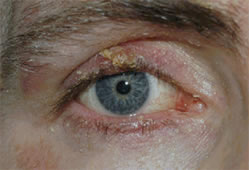 Blepharitis is an infection of the eyelids. It is very common, and it is a permanent condition. Once it is present, it will always be present, but the severity may change over time. In some cases, the symptoms can disappear for long time periods, months or years, before returning.
Blepharitis is an infection of the eyelids. It is very common, and it is a permanent condition. Once it is present, it will always be present, but the severity may change over time. In some cases, the symptoms can disappear for long time periods, months or years, before returning.
Blepharitis can be controlled by careful cleaning of your eye lashes every day. This can be accomplished with warm water and mild shampoo (such as baby shampoo). Once the redness and soreness are under control, this cleaning may be decreased from daily to twice weekly. However, if the symptoms return, daily cleansing must be resumed immediately. Medication is of secondary importance in the treatment. In some cases eye drops or ointment will be prescribed to be used along with the daily cleansing.
However, medication alone is not sufficient; keeping the eyelids clean is essential. Warm, moist compresses can also help relieve the symptoms of blepharitis when used in conjunction with regular eyelid cleansing.
There are two main causes of blepharitis: staphylococcus bacteria and seborrhea. Staphylococcus bacteria commonly begins in childhood and continues throughout adulthood. Common symptoms include collar scales on lashes, crusting, and chronic redness at the lid margin. Dilated blood vessels, loss of lashes, sties, and chalazia also occur. Treatment is very important. In addition to eliminating the redness and soreness, treatment can prevent potential infection and scarring of the cornea and conjunctiva.
Seborrhea is secondary to overactive glands causing greasy, waxy scales to accumulate along the eyelid margins. Seborrhea may be a part of an overall skin disorder that affects other areas. Hormones, nutrition, general physical condition and stress are factors in seborrhea.
(Information provided from Einstein Medical, Inc.)
